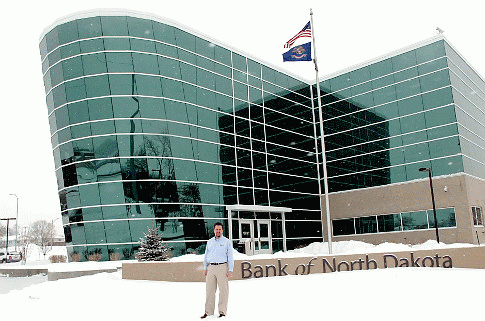While 49 state treasuries were submerged in red ink after the 2008 financial crash, one state's bank outperformed all others and actually launched an economy-shifting new industry. So reports the Wall Street Journal this week, discussing the Bank of North Dakota (BND) and its striking success in the midst of a national financial collapse led by the major banks. Chester Dawson begins his November 16th article:
It is more profitable than Goldman Sachs Group Inc., has a better credit rating than J.P. Morgan Chase& Co. and hasn't seen profit growth drop since 2003. Meet Bank of North Dakota, the U.S.'s lone state-owned bank, which has one branch, no automated teller machines and not a single investment banker.
He backs this up with comparative data on the BND's performance:
[I]ts total assets have more than doubled, to $6.9 billion last year from $2.8 billion in 2007. By contrast, assets of the much bigger Bank of America Corp. have grown much more slowly, to $2.1 trillion from $1.7 trillion in that period.
. . . Return on equity, a measure of profitability, is 18.56%, about 70% higher than those at Goldman Sachs and J.P. Morgan. . . .
Standard & Poor's Ratings Services last month reaffirmed its double-A-minus rating of the bank, whose deposits are guaranteed by the state of North Dakota. That is above the rating for both Goldman Sachs and J.P. Morgan and among U.S. financial institutions, second only to the Federal Home Loan Banks, rated double-A-plus.
Dawson goes on, however, to credit the BND's remarkable performance to the Bakken oil boom. Giving his article the controversial title, "Shale Boom Helps North Dakota Bank Earn Returns Goldman Would Envy: U.S.'s Lone State-Owned Bank Is Beneficiary of Fracking," he contends:
The reason for its success? As the sole repository of the state of North Dakota's revenue, the bank has been one of the biggest beneficiaries of the boom in Bakken shale-oil production from hydraulic fracturing, or fracking. In fact, the bank played a crucial part in kick-starting the oil frenzy in the state in 2008 amid the financial crisis.
That is how the Wall Street-owned media routinely write off the exceptional record of this lone publicly-owned bank, crediting it to the success of the private oil industry. But the boom did not make the fortunes of the bank. It would be more accurate to say that the bank made the boom.
Excess Deposits Do Not Explain the BND's Record Profits
Dawson confirms that the BND played a crucial role in kickstarting the boom and the economy, at a time when other states were languishing in recession. It did this by lending for critical infrastructure (roads, housing, hospitals, hotels) when other states' banks were curtailing local lending.
But while the state itself may have reaped increased taxes and fees from the oil boom, the BND got no more out of the deal than an increase in deposits, as Dawson also confirms. The BND is the sole repository of state revenues by law.
Having excess deposits can hardly be the reason the BND has outdistanced even JPMorganChase and Bank of America, which also have massive excess deposits and have not turned them into loans. Instead, they have invested their excess deposits in securities.
Interestingly, the BND has also followed this practice. According to Standard & Poor's October 2014 credit report, it had a loan to deposit ratio in 2009 of 91%. This ratio dropped to 57.5% in 2014. The excess deposits have gone primarily into Treasuries, US government agency debt, and mortgage-backed securities. Thus the bank's extraordinary profitability cannot be explained by an excess of deposits or an expanded loan portfolio.
Further eroding the Dawson explanation is that the oil boom did not actually hit North Dakota until 2010. Yet it was the sole state to have escaped the credit crisis by the spring of 2009, when every other state's budget had already dipped into negative territory. Montana, the runner-up, was in the black by the end of 2009; but it dropped into the red in March of that year and had to implement a pay freeze on state employees.
(Note: You can view every article as one long page if you sign up as an Advocate Member, or higher).






